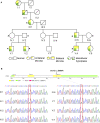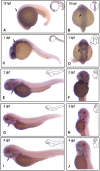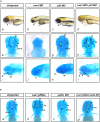A Mutation in VWA1, Encoding von Willebrand Factor A Domain-Containing Protein 1, Is Associated With Hemifacial Microsomia
- PMID: 33015062
- PMCID: PMC7509151
- DOI: 10.3389/fcell.2020.571004
A Mutation in VWA1, Encoding von Willebrand Factor A Domain-Containing Protein 1, Is Associated With Hemifacial Microsomia
Abstract
Background: Hemifacial microsomia (HFM) is a type of rare congenital syndrome caused by developmental disorders of the first and second pharyngeal arches that occurs in one out of 5,600 live births. There are significant gaps in our knowledge of the pathogenic genes underlying this syndrome.
Methods: Whole exome sequencing (WES) was performed on five patients, one asymptomatic carrier, and two marry-in members of a five-generation pedigree. Structure of WARP (product of VWA1) was predicted using the Phyre2 web portal. In situ hybridization and vwa1-knockdown/knockout studies in zebrafish using morpholino and CRISPR/Cas9 techniques were performed. Cartilage staining and immunofluorescence were carried out.
Results: Through WES and a set of filtration, we identified a c.G905A:p.R302Q point mutation in a novel candidate pathogenic gene, VWA1. The Phyre2 web portal predicted alterations in secondary and tertiary structures of WARP, indicating changes in its function as well. Predictions of protein-to-protein interactions in five pathways related to craniofacial development revealed possible interactions with four proteins in the FGF pathway. Knockdown/knockout studies of the zebrafish revealed deformities of pharyngeal cartilage. A decrease of the proliferation of cranial neural crest cells (CNCCs) and alteration of the structure of pharyngeal chondrocytes were observed in the morphants as well.
Conclusion: Our data suggest that a mutation in VWA1 is functionally linked to HFM through suppression of CNCC proliferation and disruption of the organization of pharyngeal chondrocytes.
Keywords: VWA1; cranial neural crest cell; hemifacial microsomia; whole exome sequencing; zebrafish.
Copyright © 2020 Wang, Ping, Luan, Chen, Fan, Li, Liu, Wang, Zhang, Zhang and Chen.
Figures

 indicates that whole-exome sequencing was done. (B) Sanger sequencing results of the VWA1 mutation in the pedigree. Patients III:1, IV:5, V:1, V:2 and V:4, and the asymptomatic carrier IV:1, all had the same non-synonymous point mutation (c.G905A:p.R302Q) in VWA1, whereas the two marry-in members of the family (IV:2 and IV:6) did not.
indicates that whole-exome sequencing was done. (B) Sanger sequencing results of the VWA1 mutation in the pedigree. Patients III:1, IV:5, V:1, V:2 and V:4, and the asymptomatic carrier IV:1, all had the same non-synonymous point mutation (c.G905A:p.R302Q) in VWA1, whereas the two marry-in members of the family (IV:2 and IV:6) did not.





Similar articles
-
vwa1 Knockout in Zebrafish Causes Abnormal Craniofacial Chondrogenesis by Regulating FGF Pathway.Genes (Basel). 2023 Mar 30;14(4):838. doi: 10.3390/genes14040838. Genes (Basel). 2023. PMID: 37107596 Free PMC article.
-
Functional and Genetic Analyses Unveil the Implication of CDC27 in Hemifacial Microsomia.Int J Mol Sci. 2024 Apr 26;25(9):4707. doi: 10.3390/ijms25094707. Int J Mol Sci. 2024. PMID: 38731925 Free PMC article.
-
ctdsp2 Knockout Induces Zebrafish Craniofacial Dysplasia via p53 Signaling Activation.Int J Mol Sci. 2025 Feb 3;26(3):1297. doi: 10.3390/ijms26031297. Int J Mol Sci. 2025. PMID: 39941065 Free PMC article.
-
Etiology and Pathogenesis of Hemifacial Microsomia.J Dent Res. 2018 Nov;97(12):1297-1305. doi: 10.1177/0022034518795609. Epub 2018 Sep 11. J Dent Res. 2018. PMID: 30205013 Review.
-
WARP: A Unique Extracellular Matrix Component of Cartilage, Muscle, and Endothelial Cell Basement Membranes.Anat Rec (Hoboken). 2020 Jun;303(6):1619-1623. doi: 10.1002/ar.24087. Epub 2019 Mar 5. Anat Rec (Hoboken). 2020. PMID: 30768857 Review.
Cited by
-
The Enigmatic Etiology of Oculo-Auriculo-Vertebral Spectrum (OAVS): An Exploratory Gene Variant Interaction Approach in Candidate Genes.Life (Basel). 2022 Oct 28;12(11):1723. doi: 10.3390/life12111723. Life (Basel). 2022. PMID: 36362878 Free PMC article.
-
amer1 Regulates Zebrafish Craniofacial Development by Interacting with the Wnt/β-Catenin Pathway.Int J Mol Sci. 2024 Jan 5;25(2):734. doi: 10.3390/ijms25020734. Int J Mol Sci. 2024. PMID: 38255806 Free PMC article.
-
vwa1 Knockout in Zebrafish Causes Abnormal Craniofacial Chondrogenesis by Regulating FGF Pathway.Genes (Basel). 2023 Mar 30;14(4):838. doi: 10.3390/genes14040838. Genes (Basel). 2023. PMID: 37107596 Free PMC article.
-
FOXI3 pathogenic variants cause one form of craniofacial microsomia.Nat Commun. 2023 Apr 11;14(1):2026. doi: 10.1038/s41467-023-37703-6. Nat Commun. 2023. PMID: 37041148 Free PMC article.
-
Familial Oculoauriculovertebral Spectrum: A Genomic Investigation of Autosomal Dominant Inheritance.Cleft Palate Craniofac J. 2025 Jan 17:10556656241306202. doi: 10.1177/10556656241306202. Online ahead of print. Cleft Palate Craniofac J. 2025. PMID: 39819101 Free PMC article.
References
-
- Allen J. M., Zamurs L., Brachvogel B., Schlötzer-Schrehardt U., Hansen U., Lamandé S. R., et al. (2009). Mice lacking the extracellular matrix protein WARP develop normally but have compromised peripheral nerve structure and function. J. Biol. Chem. 284 12020–12030. 10.1074/jbc.M806968200 - DOI - PMC - PubMed
LinkOut - more resources
Full Text Sources
Molecular Biology Databases
Research Materials

